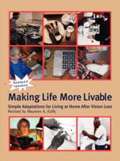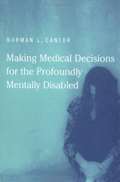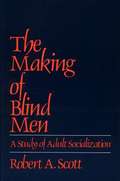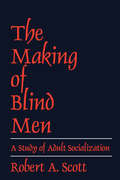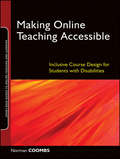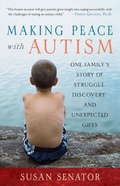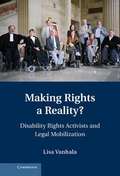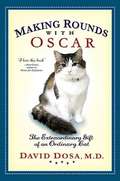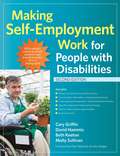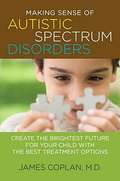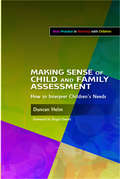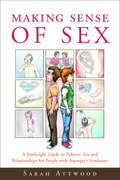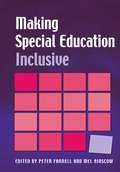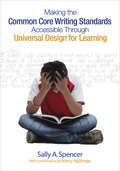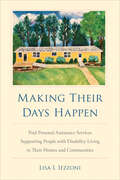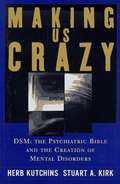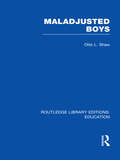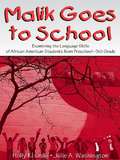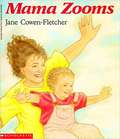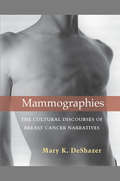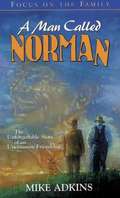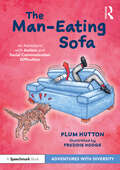- Table View
- List View
Making Life More Livable: Simple Adaptations for Living at Home after Vision Loss (Revised Edition)
by Maureen A. DuffyFrom the book: The newly revised and updated Making Life More Livable is the essential guide for adults experiencing vision loss and is an invaluable resource for their family and friends. Full of practical tips and illustrated by numerous photographs, this easy-to- use resource shows how people who are visually impaired can continue living independent, productive lives at home on their own. Useful general guidelines and room-by-room specifics provide simple and effective solutions for making homes accessible and everyday activities for individuals with visual impairments.
Making Medical Decisions for the Profoundly Mentally Disabled
by Norman L. CantorNorman Cantor analyzes the legal and moral status of people with profound mental disabilities -- those with extreme cognitive impairments that prevent their exercise of medical self-determination. He proposes a legal and moral framework for surrogate medical decision making on their behalf. The issues Cantor explores will be of interest to professionals in law, medicine, psychology, philosophy, and ethics, as well as to parents, guardians, and health care providers who face perplexing issues in the context of surrogate medical decision making. The profoundly mentally disabled are thought by some moral philosophers to lack the minimum cognitive ability for personhood. Countering this position, Cantor advances both theoretical and practical arguments for according them full legal and moral status. He also argues that the concept of intrinsic human dignity should have an integral role in shaping the bounds of surrogate decision making. Thus, he claims, while profoundly mentally disabled persons are not entitled to make their own medical decisions, respect for intrinsic human dignity dictates their right to have a conscientious surrogate make medical decisions on their behalf. Cantor discusses the criteria that bind such surrogates. He asserts, contrary to popular wisdom, that the best interests of the disabled person are not always the determinative standard: the interests of family or others can sometimes be considered. Surrogates may even, consistent with the intrinsic human dignity standard, sometimes authorize tissue donation or participation in non-therapeutic medical research by profoundly disabled persons. Intrinsic human dignity limits the occasions for such decisions and dictates close attention to the preferences and feelings of the profoundly disabled persons themselves. Cantor also analyzes the underlying philosophical rationale that makes these decision-making criteria consistent with law and morals.
The Making Of Blind Men
by Robert A. Scott<P>The disability of blindness is a learned social role. The various attitudes and patterns of behavior that characterize people who are blind are not inherent in their condition but, rather, are acquired through ordinary processes of social learning. The Making of Blind Men is intended as a systematic and integrated overview of the blindness problem in America. <P> Dr. Scott chronicles which aspects of this problem are being dealt with by organizations for the blind and the effectiveness of this intervention system. He details the potential consequences of blind people becoming clients of blindness agencies by pointing out that many of the attitudes, behavior patterns, and qualities of character that have been assumed to be given to blind people by their condition are, in fact, products of socialization. As the self-concepts of blind men are generated by the same processes of socialization that shape us all, <P>Dr. Scott puts forth the challenge of reforming the organized intervention system by critically evaluating the validity of blindness workers' assumptions about blindness and the blind. It is felt that an enlightened work force can then render the socialization process of the blind into a rational and deliberate force for positive change.
The Making of Blind Men
by Robert A. ScottThe disability of blindness is a learned social role. The various attitudes and patterns of behavior that characterize people who are blind are not inherent in their condition but, rather, are acquired through ordinary processes of social learning. The Making of Blind Men is intended as a systematic and integrated overview of the blindness problem in America. Dr. Scott chronicles which aspects of this problem are being dealt with by organizations for the blind and the effectiveness of this intervention system. He details the potential consequences of blind people becoming clients of blindness agencies by pointing out that many of the attitudes, behavior patterns, and qualities of character that have been assumed to be given to blind people by their condition are, in fact, products of socialization. As the self-concepts of blind men are generated by the same processes of socialization that shape us all, Dr. Scott puts forth the challenge of reforming the organized intervention system by critically evaluating the validity of blindness workers' assumptions about blindness and the blind. It is felt that an enlightened work force can then render the socialization process of the blind into a rational and deliberate force for positive change.
Making Online Teaching Accessible: Inclusive Course Design for Students with Disabilities
by Norman CoombsMaking Online Teaching Accessible offers online teachers, instructional designers, and content developers a comprehensive resource for designing online courses and delivering course content that is accessible for all students including those with visual and audio disabilities. Grounded in the theories of learner-centered teaching and successful course design, Making Online Teaching Accessible outlines the key legislation, decisions, and guidelines that govern online learning. The book also demystifies assistive technologies and includes step-by-step guidance for creating accessible online content using popular programs like Microsoft Office and Adobe Acrobat, as well as multimedia tools. Including a wealth of helpful tips and suggestions for effectively communicating with disabled students, the book contains practical advice on purchasing accessible course management systems, developing solutions for inaccessibility issues, and creating training materials for faculty and staff to make online learning truly accessible.
Making Peace with Autism: One Family's Story of Struggle, Discovery, and Unexpected Gifts
by Susan SenatorReceiving a diagnosis of autism is a major crisis for parents and families, who often feel as if their world has come to an end. In this insightful narrative, a courageous and inspiring mother explains why a diagnosis of autism doesn't have to shatter a family's dreams of happiness. Senator offers the hard-won, in-the-trenches wisdom of someone who's been there and is still there today--and she demonstrates how families can find courage, contentment, and connection in the shadow of autism.In Making Peace with Autism, Susan Senator describes her own journey raising a child with a severe autism spectrum disorder, along with two other typically developing boys. Without offering a miracle treatment or cure, Senator offers valuable strategies for coping successfully with the daily struggles of life with an autistic child.Along the way she models the combination of stamina and courage, openness, and humor that has helped her family to survive--and even to thrive. Topics include: the agony of diagnosis, grieving and acceptance, finding the right school program, helping siblings with their struggles and concerns, having fun together, and keeping the marriage strong.
Making Rights a Reality? Disability Rights Activists and Legal Mobilization
by Lisa VanhalaMaking Rights a Reality? explores the way in which disability activists in the United Kingdom and Canada have transformed their aspirations into legal claims in their quest for equality. It unpacks shifting conceptualizations of the political identity of disability and the role of a rights discourse in these dynamics. In doing so, it delves into the diffusion of disability rights among grassroots organizations and the traditional disability charities. The book draws on a wealth of primary sources including court records and campaign documents and encompassing interviews with more than sixty activists and legal experts. While showing that the disability rights movement has had a significant impact on equality jurisprudence in two countries, the book also demonstrates that the act of mobilizing rights can have consequences, both intended and unintended, for social movements themselves.
Making Rounds with Oscar: The Extraordinary Gift of an Ordinary Cat
by David DosaAn otherwise ordinary cat, Oscar has the uncanny ability to predict when people in the Steere House nursing home are about to die. Dr. Dosa tells the stories of several patients and examines end-of-life care as it exists today. From text: Though my interviews with decedents' families were meant to provide me with more insight into what Oscar does, I found myself learning a great deal more about the diseases that had destroyed my patients' lives than I did about the cat. For all the mystery surrounding Oscar, there was little mystery about the devastating consequences of dementia.
Making Self-Employment Work for People with Disabilities (Second Edition)
by Cary Griffin David Hammis Beth Keeton Molly Sullivan<p>As self-employment becomes a viable option for more and more adults with significant disabilities, give them realistic, practical guidance and support with the NEW edition of this popular guidebook. Updated with a new and improved assessment approach, more self-employment success stories, and the latest on policy changes and online opportunities, this book is your step-by-step guide to helping adults with disabilities get a small business off to a strong start. You'll discover the nuts and bolts of person-centered business planning, and you'll get concrete, step-by-step strategies for every aspect, from business plans to marketing to finances. A must-have resource for employment specialists, transition professionals, and individuals with disabilities and their families, this book is the go-to guide for turning a small business into a big success. <p> <p>SUPPORT PEOPLE WITH DISABILITIES AS THEY: <p> <li>discover their "personal genius" with a new assessment approach <li>build a thorough and professional business plan based on their goals and interests <li>successfully finance their small business using multiple revenue sources <li>market their business, from defining customers to advertising in a variety of media <li>maintain their benefits while navigating financial and social security systems <li>make the most of valuable support from rehabilitation personnel, vocational counselors, school transition staff, and community programs</li> </p>
Making Sense of Autistic Spectrum Disorders: Create the Brightest Future for Your Child with the Best Treatment Options
by James CoplanIn this authoritative and empowering book, one of the world's leading experts on early child development gives caregivers of children on the autistic spectrum the knowledge they need to navigate the complex maze of symptoms, diagnoses, tests, and treatment options that await them. For more than thirty years, James Coplan, M.D., has been helping families cope with the challenges posed by autistic spectrum disorders (ASD). Each family that walks into his office, he knows, is about to begin a journey. With this book, he lays out the steps of that journey. Dr. Coplan brings you into the treatment rooms and along for the tests and evaluations, and provides the kind of practical hands-on guidance that will help you help your child with ASD through every phase of life. At a time when ASD has become the subject of wild theories and uninformed speculation, Dr. Coplan grounds his recommendations in reality. He helps you understand for yourself where your child may be on the spectrum that includes autism, Asperger Syndrome, and Pervasive Developmental Disorder-Not Otherwise Specified. His clear, comprehensive, and compassionate advice prepares you to make informed medical decisions, evaluate the various educational and therapeutic alternatives, and find answers to such fundamental questions as "How do I optimize my child's long-term potential?"; Which interventions will best serve my child?"; How do the various therapies work, and what is the evidence to support them?"; What is the best way to teach my child?" This book empowers you to be an expert advocate for your child, so that you'll know when to say no to an ill-advised therapy or medication and can make with confidence the hundreds of important decisions you will face in the years ahead. For every parent who has made the painful transition from "Why did this happen?" to "What can we do to help our child?," here is the indispensable guidebook you've been waiting for.
Making Sense of Child and Family Assessment
by Duncan HelmThe application of assessment frameworks hinges on human qualities and skills which are naturally prone to bias and inconsistency. Making Sense of Child and Family Assessment aims to support workers in analysing and making sense of the information gathered, and increasing accuracy and empathy in assessing the needs and risks for vulnerable children and young people. This book offers best practice guidance on how to analyse information gathered during the assessment of children and young people and their families. Good assessments take time and need to be appropriately resourced. A range of analytical tools are also needed if practitioners are to present assessments of children's needs which lead to meaningful care plans and improved outcomes. Helm introduces the key messages emerging from policy and research, and provides insights into today's multi-disciplinary practice. Professionals working in child welfare and protection roles, such as social workers, health visitors, midwives and teachers will find this practical guide to analysis invaluable in interpreting needs and outcomes.
Making Sense of Sex: A Forthright Guide to Puberty, Sex and Relationships for People with Asperger's Syndrome
by Sarah AttwoodPuberty is a time of huge change in the physical body, in emotional experience and in social relationships. Having an understanding of these developments and learning how to deal with them is essential, and for people with Asperger's syndrome it can be a challenge to get to grips with the social and emotional aspects of puberty, sex and relationships. This book is ideal for those who need clear, detailed explanations and direct answers to the many questions raised by puberty and sexual maturity. Sarah Attwood describes developments in both the male and female body, and explains how to maintain hygiene and personal care, and to promote general good health. She examines emotional changes, including moods and sexual feelings, and provides comprehensive information on sex, sexual health and reproduction. She looks at the nature of friendship, how it changes from childhood to adulthood and its importance as a basis for sexual encounter. She also offers coping strategies for different social experiences, from bullying to dating, and includes essential tips on the politics of mature behaviour, such as knowing the difference between public and personal topics of conversation. Making Sense of Sex is a thorough guide written in unambiguous language with helpful diagrams, explanations and practical advice for young people approaching puberty and beyond.
Making Special Education Inclusive: From Research to Practice
by Peter Farrell Mel AinscowThe aim of this book is to consider how schools and LEAs can develop inclusive policies and practices for students who experience a range of difficulties in learning or behavior. It highlights debates and contradictions about the realities of inclusion and suggests ways in which practice can move forward. The contributors look at key areas of development in special and inclusive education and considers ways in which the latest research can inform practice. Areas covered include promoting inclusion for all; how to make sense of the Code of Practice SEN Thresholds; working with Teaching Assistants; new approaches to counseling and pastoral care in schools; including pupils with EBD; how nurture groups are helping inclusive practice; making education inclusive for pupils with sensory disabilities; including pupils with specific learning difficulties; and preparing students for an inclusive society. The book will be of particular interest to teachers, LEA support staff, educational psychologists and related professionals who face the challenge of meeting the needs of a diverse population within an inclusive framework. it will also be of relevance for students in further and higher education, and their tutors.
Making the Common Core Writing Standards Accessible Through Universal Design for Learning
by Sally A. SpencerUnlock hidden writing skills in all learners through UDL! The Common Core State Standards (CCSS) for writing are promising but are challenging to implement, especially for struggling students. Sally A. Spencer demonstrates the promise of Universal Design for Learning (UDL) as a framework for making the CCSS writing and language standards accessible to all kids. Educators who utilize these strategies will know: How to leverage the strengths of students to optimize writing instruction and overcome their weaknesses The ways UDL can minimize the roadblocks in CCSS implementation How to - and how not to - use technology to teach writing and language conventions
Making the Common Core Writing Standards Accessible Through Universal Design for Learning
by Sally A. SpencerUnlock hidden writing skills in all learners through UDL! The Common Core State Standards (CCSS) for writing are promising but are challenging to implement, especially for struggling students. Sally A. Spencer demonstrates the promise of Universal Design for Learning (UDL) as a framework for making the CCSS writing and language standards accessible to all kids. Educators who utilize these strategies will know: How to leverage the strengths of students to optimize writing instruction and overcome their weaknesses The ways UDL can minimize the roadblocks in CCSS implementation How to - and how not to - use technology to teach writing and language conventions
Making the Transition from High School to College for Students with Disabilities:
by Colleen LewisMaking the Transition from High School to College for Students with Disabilities
Making Their Days Happen: Paid Personal Assistance Services Supporting People with Disability Living in Their Homes and Communities
by Lisa I. IezzoniMost Americans—even those with significant disability—want to live in their homes and communities. Unpaid family members or friends often work as “informal” caregivers, helping those who need assistance— and many feel they have no option but to serve. In contrast, paid personal assistance services workers (PAS) provide a lifeline to those consumers with complex needs and limited social networks. However, there is a crisis looming in the increasing needs for paid PAS and the limited available PAS workforce. Making Their Days Happen explores disability, health, and civil rights, along with relevant federal and state labor policies related to personal assistance services. Lisa Iezzoni addresses the legal context of paid PAS as well as financing mechanisms for obtaining home-based personal assistance. She also draws upon interviews she conducted with paid PAS consumers and PAS workers to explore PAS experiences and their perspectives about their work. Offering recommendations for improving future experiences of PAS consumers and providers, Iezzoni emphasizes that people with disabilities want to be a part of society, and PAS workers who do this low-wage work find satisfaction in helping them achieve their goals.
Making Us Crazy: The Psychiatric Bible and the Creation of Mental Disorders
by Herb Kutchins Stuart A. KirkThe authors map the complex, quirky history of the DSM, often called the "psychiatric Bible" from its inception in the early 1950s to the present. They show that the DSM has been used and misused to shape social policy toward people with mental illnesses. The DSM has also been highly subject to political currents. Specific "diagnoses" such as homosexuality, borderline personality, and post-traumatic stress disorder are discussed in depth as illustrations.
Maladjusted Boys (Routledge Library Editions: Education)
by Otto ShawWritten by the founder of a pioneering establishment for disruptive boys who had been excluded from mainstream schools and in some cases turned to crime, this book discusses the methods and reasons for success of Red Hill School. It also discusses the causes of disruptive or obsessive behaviour and emphasizes how the therapeutic work of Red Hill has helped the pupils involved to adjust socially and psychologically so that they go on to find personal fulfilment and satisfaction.
Malik Goes to School: Examining the Language Skills of African American Students From Preschool-5th Grade
by Holly K. Craig Julie A. WashingtonMalik Goes to School: Examining the Language Skills of African American Students From Preschool-5th Grade synthesizes a decade of research by the authors, Holly Craig and Julie Washington, on the oral language and literacy skills of African American children from preschool to fifth grade. Their research has characterized significant influences on the child's use of AAE and the relationship between AAE and aspects of literacy acquisition. The research has also led to the characterization of other nondialectal aspects of language development. The outcome has been a culture-fair, child-centered language evaluation protocol.This very readable volume will be important to students, clinicians, and teachers, learning about and working with, African American children. The book has direct relevance to academic planning, clinical decision-making, curriculum development, and educational policymaking.
Mama Zooms
by Jane Cowen-FletcherA boy's wonderful mama takes him zooming everywhere with her, because her wheelchair is a zooming machine.
Mammographies: The Cultural Discourses of Breast Cancer Narratives
by Mary K. DeshazerWhile breast cancer continues to affect the lives of millions, contemporary writers and artists have responded to the ravages of the disease in creative expression. Mary K. DeShazer's book looks specifically at breast cancer memoirs and photographic narratives, a category she refers to as mammographies, signifying both the imaging technology by which most Western women discover they have this disease and the documentary imperatives that drive their written and visual accounts of it. Mammographies argues that breast cancer narratives of the past ten years differ from their predecessors in their bold address of previously neglected topics such as the link between cancer and environmental carcinogens, the ethics and efficacy of genetic testing and prophylactic mastectomy, and the shifting politics of prosthesis and reconstruction. Mammographies is distinctive among studies of contemporary illness narratives in its exclusive focus on breast cancer, its analysis of both memoirs and photographic texts, its attention to hybrid and collaborative narratives, and its emphasis on ecological, genetic, transnational, queer, and anti-pink discourses. DeShazer's methodology--best characterized as literary critical, feminist, and interdisciplinary--includes detailed interpretation of the narrative strategies, thematic contours, and visual imagery of a wide range of contemporary breast cancer memoirs and photographic anthologies. The author explores the ways in which the narratives constitute a distinctive testimonial and memorial tradition, a claim supported by close readings and theoretical analysis that demonstrates how these narratives question hegemonic cultural discourses, empower reader-viewers as empathic witnesses, and provide communal sites for mourning, resisting, and remembering.
Man Behind the Voice
by Lisa BinghamDetermined to locate the accident victim he'd comforted as her eyesight waned, Jack MacAllister told himself he only wanted to know that she was all right. But when he found Eleanor Rappaport again, he knew he couldn't fade into the shadows this time. She was alone and blind-and pregnant! Eleanor's life had become a lonely struggle-until a stranger's soothing words pierced the darkness. Why did his oddly familiar voice make her heart beat faster? On the brink of motherhood, Eleanor thought she needed space. But maybe she needed Jack more.... Harlequin American Romance #835
A Man Called Norman
by Mike AdkinsThis is the moving story of two men, an eccentric old man and a Christian musician, whose lives intertwine in a way that neither would have expected and only God could have planned.
The Man-Eating Sofa: An Adventure with Autism and Social Communication Difficulties (Adventures with Diversity)
by Plum HuttonPeople often say that ‘school is the best time of your life’, but for Lara, school is loud and confusing. She much prefers watching James Bond films or building furniture in her dad’s workshop. When the teachers at Lara’s new school realise that she is autistic, they are able to help with strategies to make school more tolerable for her. All except Mr Prender-ghastly. The headmaster has been looking for a way to gently direct Mr Prendergast towards a change of career, but it is Lara, and her special man-eating sofa, who finally help rid the school of the fearsome teacher. This entertaining story, suitable for readers aged 8-12, explores some of the challenges faced by autistic pupils and those with social communication and interaction difficulties in mainstream schools. It highlights the stress and anxiety that young people with sensory processing and social interaction difficulties may feel in the noisy and unpredictable school environment, and identifies some strategies that can be used to support them. Also available as a set with a supporting guide, this book operates as a fun and engaging standalone story, both for children who are autistic themselves and those who are not. It is a must-have book for every classroom.
